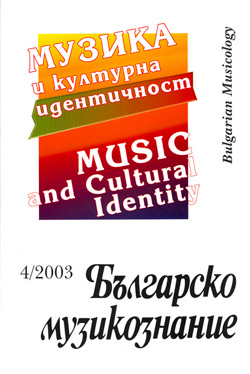Хармонията на Веселин Стоянов: щрихи към проблема за музикалното мислене като знак на културна идентичност
The Harmony of Vesselin Stoyanov: An Outline of the Problem of Musical Thinking as a Sign of Cultural Identity
Author(s): Mariana BulevaSubject(s): Music
Published by: Институт за изследване на изкуствата, Българска академия на науките
Summary/Abstract: In contemporary Bulgarian musicology the phrase “musical thinking” is widely used, but most frequently it comprises phenomena from the style of a certain composer, and not thinking as a mental process and the parameters of musical language as its operational system. The music of Vesselin Stoyanov has stable stylistic features and is a rich artistic object for studying of the problem of musical language-cultural identity. The creators from the generation of Vesselin Stoyanov were formed in a new cultural environment: in the music of the first Bulgarian composers the folklore modal music had already met with the voluminous tempered space of the European musical system. On national soil the possibility for the organic penetration of modal stereotypes “downwards” into the functional foundations of tonal verticals had been prepared. Therefore in the consciousness of each author the possibility to cultivate musical language, in which the significant units are organically connected in the thought along with their contemporary and national cultural identity, was preconditioned. In Vesselin Stoyanov’s music we can observe the support of a specific sound concept at the start of many musical themes: T7 -dor. S. With most composers musical thinking lies within the framework of mixodiatonic tone type, which expands the diatonic tone material with two more fifth moves. The quantitative border of musical thinking is likely to be the reason for the dissemination of the mode tone-semitone .A hypothesis can be suggested that it is reached by “pouring out” of tones from the chromatic tone type, which exceeds the phonic level of musical language, characteristic for the Bulgarian composers during the 1930s and early 1940s.
Journal: Българско музикознание
- Issue Year: 2003
- Issue No: 4
- Page Range: 147-154
- Page Count: 8
- Content File-PDF

